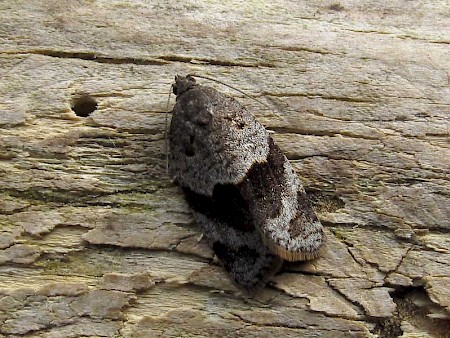49.028 BF986
Syndemis musculana
(Hübner, [1799])
Wingspan 15-22 mm.
On this moth, both forewings and hindwings are primarily grey. The forewing ranges from whitish grey to brownish grey, with darker markings, which vary in intensity. Some, especially worn specimens, lack discernable markings.
It is common throughout Britain and Ireland in a variety of habitats, including mountains, moorlands and woodlands. It flies in the late afternoon and evening in May and June, coming to light after dusk.
The larva feeds from a leaf spinning or folded leaf, on bramble (Rubus), birch (Betula) and oak (Quercus), and many other trees, shrubs, herbs and grasses. It is active from July to October, overwintering as a full-grown larva to pupate in Spring.
Several other polyphagous species have similar brown larvae; see detailed description below for help in distinguishing them.
Larva: (description Ian F. Smith)
Foodplant: Polyphage. Especially Rubus, Betula and Quercus, and many other trees, shrubs, herbs and grasses, including Picea, Larix, Salix, Succisa, Calystegia, Poterium and Senecio. Feeds from a leaf spinning or folded leaf, from July to September, overwintering as a full-grown larva to pupate in April - May.
Length: 16 mm and 18 mm described
Head: Light burnt ochre mottled with darker burnt ochre. Clypeus and base of antenna translucent white. Pitchy black posterolateral mark. Stemmatal area pitchy black.
Prothoracic shield: Translucent yellowish brown. Divided by thin inconspicuous whitish medial line. Very large pitchy black lateral mark.
Thorax (T2&3): Often, but not always, noticeably paler dorsally than abdomen; brownish yellow, contrasting with dark brown dorsal line.
Thoracic legs: Yellowish brown, darker brown on base of femur and on claw.
Body: Dorsally and laterally down to spiracles greyish brown (or olive, or yellowish green; BTS). Broad subspiracular band of brownish cream. Ventrally greyish cream.
Spiracles: Fine brown peritreme.
Pinacula: Brownish cream.
Setae: Translucent tinted light brown.
Anal segment: Anal comb of about six reddish brown prongs.
Anal plate; medially yellowish brown, laterally pitchy black.
Prolegs: Brownish cream. Crochets reddish brown.
Similar species: Specimens with the pale thoracic dorsum are distinctive, but when it is dark, the body is very similar to Clepsis spectrana. The head colour, and patterns on the thoracic shield and anal plate should be compared carefully.
Other brown polyphagous larvae, which might be confused with Syndemis musculana include:
Celypha lacunana (Dark venter. Pinacula as body. Plates black. Lobe on posterior of anal plate),
Orthotaenia undulana (Dark venter. Pinacula as body. Plates black.)
Aphelia viburnana (Pinacula whitish. Dark venter. Compare thoracic shield and anal plate. Frequent on Vaccinium).
Other species may resemble Syndemis musculana, so rearing is advised for positive identification.

 UKMoths
UKMoths 








